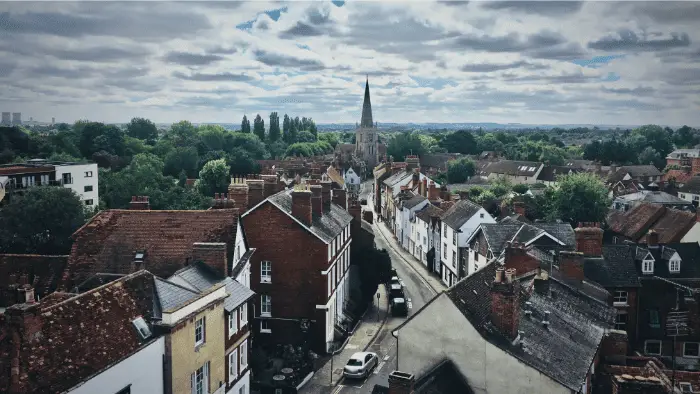If you’re thinking of taking a trip around the history of England, there are few better ways to do this than by visiting its oldest towns.
Unsurprisingly, there are plenty of contenders for the title of the oldest town in England, especially if you consider the different ways we can define this.
Below, we’ll look at the 10 oldest towns in England, along with a look at their main historical appeal. Before we jump into the list, though, we should think about how we’re going to define “oldest town in England”.
What are the Oldest British Towns?
Defining a town as old might sound pretty easy. After all, it’ll be the one that can trace its history back the farthest, right?
Not necessarily. Without getting too deep into potentially boring historical titles and definitions, many current British settlements can be traced back to the Stone Age or Iron Age.
Plenty of towns and cities are located where they are because they’re near water or defendable locations. Over time, they were simply built up into modern towns and cities.
Then we must decide whether we’re counting them as an old town only from when they became a town. If that’s the case, then all old towns will start around the 12th century, as this is when the word “town” came to mean a settlement larger than a village.
Instead, we’ll use a combination of these two metrics. We’ll include settlements that are definitely towns by our modern standards but that can trace their human habitation back pretty far.
That said, we’ll only include really old settlements where there’s something worth seeing that goes back to the Stone Age or Iron Age.
After all, it’s not super interesting to say a settlement is old because archaeologists found some flints in a field.

1. Abingdon
Formally Abingdon-on-Thames in Oxfordshire, this town claims to be the oldest in Britain in continuous habitation.
Within the current town boundaries, there’s evidence of human settlement dating all the way back to the Palaeolithic period (roughly 2.5 million-12,000 years ago).
Importantly, Abingdon was a Roman town that remained in use when many others were abandoned. It was picked up by the Saxons and became an important medieval trade centre.
It was well known for its wool and weaving industries, and was also one of the earliest English market towns.
There are plenty of remains of its historic lineage. You can find an old castle near the town centre as well as remains of a Napoleonic jail and a WW2 pillbox.
Of course, there are plenty of interesting buildings to see too, and some nice walks along the Thames, which spans through the town centre.

2. Colchester
Colchester, in Essex, claims to be the oldest recorded town in Britain. Specifically, it’s mentioned in Pliny the Elder’s Natural History, which he wrote in the first century AD.
Considering this isn’t far off when recorded history came to the UK, it’s a fairly accurate claim for Colchester to make.
Like Abingdon, there’s evidence of Stone Age habitation. Another claim Colchester can make is that it has the oldest Roman town walls in Britain – they’re at least 150 years older than any others.
You can still see plenty of evidence of these as well as medieval buildings in the historic town centre. There’s also a Dutch quarter featuring buildings from the 16th century, along with buildings from the following centuries.

3. Ipswich
Ipswich, in Suffolk, received its market charter in 1200, which was quite early. This was one of the earliest ways of defining a medieval town, as it meant it was allowed to hold a market with royal permission.
Its claim as the oldest English town stems from the fact that it’s the only one definitively in what was to become England. According to Ipswich’s council, it’s the only settlement where its residents could be defined by their collective use of the Old English language.
Regardless, there are buildings dating back to the 15th century that you can still visit, along with historic museums and parks.
St Margaret’s Church, near Sloane Street, dates back to the 13th century – you can still see some evidence of its original construction.
4. Thatcham
Located in Berkshire, Thatcham is another contender for the oldest continuously inhabited settlement in the UK. Unlike Abingdon, Thatcham actually made it into the Guinness Book of World Records, so it’s arguably got a better claim.
Unlike Abingdon, though, its name has barely altered in nearly 1500 years. It’s believed to come from the Saxon Taceham, meaning Tac’s village.
The current spelling of Thatcham was adopted in the 16th century, although it hadn’t gone through many changes before then.
There are plenty of interesting old buildings to see, including the Old Bluecoat School, a Grade I listed chapel, and evidence of Mesolithic settlements.
While it’s perhaps not as interesting as somewhere like Colchester, there should be plenty on offer for those interested in local history.
5. Amesbury
Amesbury, in Wiltshire, has a pretty good claim to being an old English town: it’s the location of Stonehenge.
While this isn’t directly related to the town itself, it’s pretty good evidence of it being inhabited for a long time.
In the local area, there’s an Iron Age hill fort known as Vespasian’s Camp as well as plenty of Roman remains. The town itself has numerous historic buildings, including a 10th-century abbey, and the Red House, an 18th-century farmhouse.
Amesbury is also associated with Arthurian legend. It’s believed to be the burial site of Guinevere, who retired to the abbey after the events of the Arthurian legends.
A lot of local tourism relates to this, so it’s definitely worth checking out if you’re visiting the area.
6. St Ives
Perhaps one of the most famous towns on this list, St Ives, in Cornwall, can trace its naming back to the 5th century. I
t’s believed to be the landing site of the Irish saint Ia, who’s believed to have brought Christianity to Cornwall. It’s likely there was a settlement in this location before then, but this is when it was definitely named.
St Ives was a popular medieval town, and has become one of the main tourist destinations in Cornwall. It has the second-highest tourist-related spending in the UK, totalling around £85 million a year.
St Ives has also been named the best seaside town in the UK, and the most expensive.
There are plenty of sites to visit in St Ives, many of which relate to its fishing and maritime histories. St Ia’s Church was built in the early 15th century, although there was likely a church on the site before the current building.
There’s also plenty of art-related culture in St Ives, making it a great destination for pretty much anyone.
7. Arundel
Compared to other entries on this list, Arundel, in West Sussex, isn’t that old. It was first recorded in the Domesday Book (1086), although this is the case for a lot of English settlements.
However, the fact that it’s located in Sussex and that its name comes from Old English, implies it’s from at least the 5th century or so.
It’s worth mentioning here because Arundel has made a big point of conserving its historical buildings. There’s a medieval castle that’s been restored, and numerous old buildings in the town centre.
In fact, it has the second-highest number of listed buildings in West Sussex. It’s second to Chichester, a much bigger settlement.
There’s a museum that’s worth visiting – as is the castle itself. Other than that, it’s enough to just walk around the town centre, as there’s loads to see without spending money.
8. Whitby
Whitby, in North Yorkshire, can trace its recorded history back to the 7th century. Although it goes by many different names, the current name of Whitby dates from roughly the 12th century, when it was known as Hwitebi.
It’s perhaps most famous for its ruined abbey, which also dates back to the 7th century. Despite being a ruin, it’s quite well preserved, as a surprising amount still stands.
Also, if you know anything about literature, you’ll know it served as the inspiration for Bram Stoker’s Dracula.
In the town itself, many of its main historical buildings date from the 17th and 18th centuries. Whitby became a major shipbuilding hub during this time, and its growth in wealth is evident in its architecture.
It also became a popular spa town in the Georgian era, so there are plenty of hotels from this time.
9. Selby
Another entry from North Yorkshire, Selby is believed to be the historic site of a Viking settlement. However, there’s archaeological evidence of Roman habitation on the site, too, pushing its timeline back by a few centuries.
Selby was an important settlement because it sits on the traditional route from the Midlands to the north. During the Industrial Revolution, Selby had a shipbuilding industry and was a port of the Selby Canal, which connected Leeds to the coast.
You can still visit Selby Abbey, an 11th-century church (one of the largest in the UK) as well as numerous other old religious buildings.
Much of Selby’s historic architecture dates from the 18th century onwards, making it a good choice for those interested in more modern history.
10. Lowestoft
Lowestoft, in East Suffolk, has another good claim for the oldest settlement in the UK. Flint tools were found in an area south of the town that date back 700,000 years!
However, confirmed habitation of the actual settlement that is Lowestoft starts around the Neolithic period (10,000 BC).
There’s evidence of Iron Age, Roman, Saxon and Viking settlements, and the town of Lowestoft was recorded in the Domesday Book.
In the Middle Ages, it became a popular fishing town and was a major site for herring. This is partly why it was awarded a royal charter to hold markets.
It was also the site of a porcelain factory, and Lowestoft played an important role in WW1. You can see evidence of all of this around the town, although it was heavily bombed in WW2.
It was long seen as a popular seaside resort, which is where much of its modern tourism stems from too.
Final Thoughts
Hopefully, this list will give you some inspiration for historic towns to visit in England. As you can see, there are numerous ways to define “oldest town”, but most boil down to some evidence of Stone Age habitation.
While this isn’t particularly interesting in terms of visible history, there’s usually some more modern history to engage with.
If you’re looking to delve really deep into the history of English towns, start looking at their names’ etymologies.
This is usually a useful way of determining how old a settlement is, and can make an interesting project for working out old towns.


